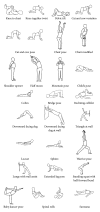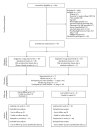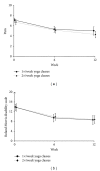Comparing Once- versus Twice-Weekly Yoga Classes for Chronic Low Back Pain in Predominantly Low Income Minorities: A Randomized Dosing Trial
- PMID: 23878604
- PMCID: PMC3710634
- DOI: 10.1155/2013/658030
Comparing Once- versus Twice-Weekly Yoga Classes for Chronic Low Back Pain in Predominantly Low Income Minorities: A Randomized Dosing Trial
Abstract
Background. Previous studies have demonstrated that once-weekly yoga classes are effective for chronic low back pain (cLBP) in white adults with high socioeconomic status. The comparative effectiveness of twice-weekly classes and generalizability to racially diverse low income populations are unknown. Methods. We conducted a 12-week randomized, parallel-group, dosing trial for 95 adults recruited from an urban safety-net hospital and five community health centers comparing once-weekly (n = 49) versus twice-weekly (n = 46) standardized yoga classes supplemented by home practice. Primary outcomes were change from baseline to 12 weeks in pain (11-point scale) and back-related function (23-point modified Roland-Morris Disability Questionnaire). Results. 82% of participants were nonwhite; 77% had annual household incomes <$40,000. The sample's baseline mean pain intensity [6.9 (SD 1.6)] and function [13.7 (SD 5.0)] reflected moderate to severe back pain and impairment. Pain and back-related function improved within both groups (P < 0.001). However, there were no differences between once-weekly and twice-weekly groups for pain reduction [-2.1 (95% CI -2.9, -1.3) versus -2.4 (95% CI -3.1, -1.8), P = 0.62] or back-related function [-5.1 (95% CI -7.0, -3.2) versus -4.9 (95% CI -6.5, -3.3), P = 0.83]. Conclusions. Twelve weeks of once-weekly or twice-weekly yoga classes were similarly effective for predominantly low income minority adults with moderate to severe chronic low back pain. This trial is registered with ClinicalTrials.gov NCT01761617.
Figures





References
-
- Sherman KJ, Cherkin DC, Erro J, Miglioretti DL, Deyo RA. Comparing yoga, exercise, and a self-care book for chronic low back pain: a randomized, controlled trial. Annals of Internal Medicine. 2005;143(12):849–856. - PubMed
-
- Tilbrook HE, Cox H, Hewitt CE, et al. Yoga for chronic low back pain: a randomized trial. Annals of Internal Medicine. 2011;155(9):569–578. - PubMed
-
- Williams KA, Petronis J, Smith D, et al. Effect of Iyengar yoga therapy for chronic low back pain. Pain. 2005;115(1-2):107–117. - PubMed
Associated data
Grants and funding
LinkOut - more resources
Full Text Sources
Other Literature Sources
Medical

